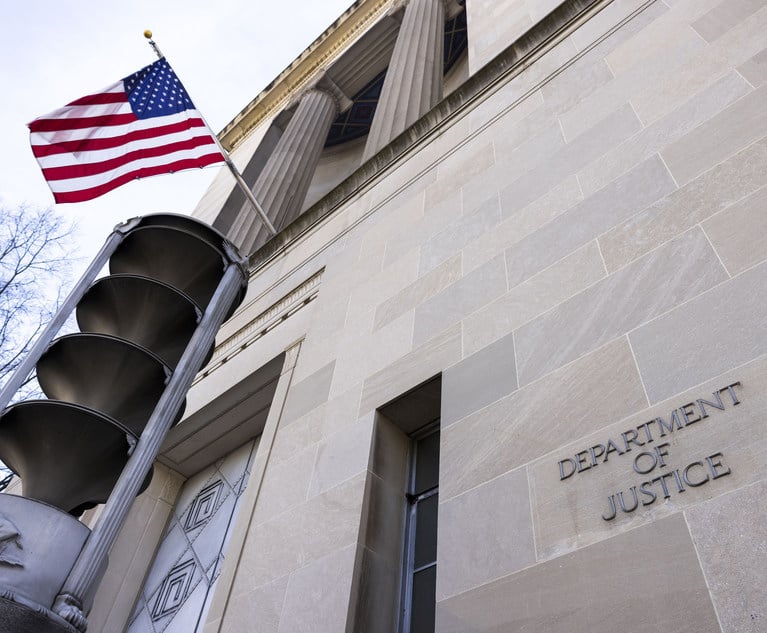 Michael Rikon
Michael RikonHow Do We Get to the Beach?
In his Condemnation and Tax Certiorari column, Michael Rikon writes: The U.S. Supreme Court denied certiorari on Oct. 1, 2018 to 'Martins Beach 1 v. Surfrider Foundation'. The court refused to hear an appeal by an owner to overturn a ruling that a beach access path must stay open.
October 22, 2018 at 02:45 PM
8 minute read
The U.S. Supreme Court denied certiorari on Oct. 1, 2018 to Martins Beach 1 v. Surfrider Foundation, __ U.S. __, 2018 U.S. LEXIS 5704. The court refused to hear an appeal by an owner to overturn a ruling that a beach access path must stay open.
The access to the beach was located near Half Moon Bay, Calif. The property never had public access. The beach could only be accessed by driving down a private road after the payment of a fee. There was no question that the public owns the portion of Martins Beach below the high-tide line. After the property was acquired by a new owner, the county demanded that the beach be open to the public year-round. The basis for demand was the California Coastal Act of 1976. The petition for certiorari alleged that the physical invasion of private property is a per se taking and that the Coastal Act cannot constitutionally be applied to compel uncompensated physical invasions of private property. After all, the right to exclude others is “one of the most essential sticks in the bundle of rights that are commonly characterized as property.” Loretto v. Teleprompter Manhattan CATV, 458 U.S. 419, 433 (1982).
In prior cases, the Supreme Court has not hesitated to strike down coercive conditions which violate the Taking Clause. In Nollan v. Cal. Coastal Comm'n, 483 U.S. 825 (1987), the court struck down the requirement that an easement be granted over their beach front as a condition for a permit to rebuild their house. The court reaffirmed the principle in Dolan v. City of Tigard, 512 U.S. 374 (1994), where the City required a public-access walkway as a condition to expand a building. The court held there must be an “essential nexus” between what the landowner is seeking and the need for public access. As it stands, the owner of Martins Beach must continue to keep open a money-losing business. According to the Amicus brief of the California Association of Realtors, there are some 1.5 million acres of coastal land that are affected by the Coastal Act and may require permits to simply lock a gate and protect lawfully owned property. The Martins Beach case is far from over, the Coastal Act provides that an owner may apply for a permit to close the road. If that permit is denied, you can be sure further litigation will ensue.
But the Supreme Court has upheld public beach access. In Stop The Beach Renourishment,v. Environmental Protection, 560 U.S. 702 (2010), the court held that it was proper for Florida to provide for public beach access when there is beach renourishment since the taxpayer funded sand belongs to and benefits the public.
In New York it is state policy to provide public access to beaches.
Subdivision 4 of §912 of New York's Executive Law provides that, inter alia, within coastal areas, it is the public policy of the state of New York “to encourage and facilitate public access for recreational purposes.”
In Smith v. State of New York, 153 A.D.2d 737 (2d Dept. 1989), the Second Department held that while a conveyance might have been made of land and beaches around the city of Glen Cove, any such conveyance must comport with the best public use and not be injurious to the public good. The court stated in Smith:
[E]xclusion of the public from enjoying the area which they have lawfully enjoyed for over 100 years would constitute an impermissible impairment of the public interest.
As was declared in Illinois Cent. R.R. v. Illinois (146 US 387, 452-453), “abdication of the general control by the State over lands under the navigable waters … is not consistent with the exercise of that trust which requires the government of the State to preserve such waters for the use of the public. The trust devolving upon the State for the public, and which can only be discharged by the management and control of property in which the public has an interest, cannot be relinquished by a transfer of the property. The control of the State for the purposes of the trust can never be lost, except as to such parcels as are used in promoting the interests of the public therein, or can be disposed of without any substantial impairment of the public interest in the lands and waters remaining” (see also, Marba Sea Bay Corp. v. Clinton St. Realty Corp., 272 NY 292, 296; Tiffany v. Town of Oyster Bay, 234 NY 15, 20, 21; People v. Steeplechase Park Co., 218 NY 459).
While the state may convey a fee interest in lands under water to an individual, the contemplated use by the grantee or his successors in interest must comport with the best public use and not be injurious to the public good (see Matter of Long Sault Dev. Co., 212 N.Y. 1, 8, 9). Additionally, this fee interest may be revoked by the state when the uses proposed are not in conformity with the public trust doctrine. This doctrine grows out of the common-law concept of the jus publicum, the public right of navigation and fishery which supersedes a private right of jus privatum (see Lewis Blue Point Oyster Cultivation Co. v. Briggs, 198 N.Y. 287, 292, 293; Coxe v. State of New York, 144 N.Y. 396, 406, 407; 3 Warren's Weed, New York Real Property, Land Under Water, §§2.02, 3.05 [4th ed.]). 153 A.D.2d at 739-40.
New Jersey has applied the public trust doctrine in several recent cases. In the wake of superstorm Sandy, the state adopted legislation requiring municipalities that accept state and federal aid to rebuild storm-damaged beaches to provide beach access to the public free of charge. Public access pursuant to the doctrine was upheld by the New Jersey Supreme Court in Raleigh Avenue Beach Assoc. v. Atlantis Beach Club, 185 N.J. 40 (2005). The New Jersey courts have also denied claims for just compensation after easements were acquired for shore protection purposes. Also considered was whether the easements can allow public access to, and use of, the areas covered by the easements. The New Jersey Supreme Court set a new valuation standard in Borough of Harvey Cedars v. Karan, 70 A.3d 524 (2013).
The court held that just compensation must be based upon a consideration of “all relevant, reasonably calculable, and non-conjectural factors that either decrease or increase the remaining property.” In Karan, the court found that the new sand dune conferred unique storm protection and awarded $1.00 for the taking.
In Marba Sea Bay v. Clinton Street Realty, 272 N.Y. 292 (1936) rehearing den. 278 N.Y. 485 (1938) it was held that the grant of the foreshore to a private person is not recognizable by the law. The court held, “the title which the State holds and the power of disposition is an incident and part of its sovereignty that cannot be surrendered, alienated or delegated, except for some public purpose, or some reasonable use which can fairly be said to be for the public benefit.” 272 N.Y. 292, at 296.
There have been recent challenges to beach access, notably in Long Island. These law suits usually seek a determination pursuant to RPAPL Article 15 that the upland owners have title to entire beach and thus possess the right to exclude the public. But the burden of proof will rest with the plaintiff. It is the rare case where the ocean front homeowner wins the right to bar the public.
In eastern Long Island there exist trustees who own and control much of the land on the water. The Trustees of the Freeholders and Commonalty of the Towns of East Hampton and Southampton represent the original government of the Towns.
The Trustees' rights to hold or sell land drive from the Dongan Patent of 1686, a colonial document which ratified a prior 1666 grant of lands in East Hampton to the Trustees of the Freeholders and Commonalty of the Town of East Hampton in a trust and for the use of the inhabitants of the Town mentioned. Trustees of Freeholders & Commonalty v. Kirk, 68 N.Y. 459 (1877). The Southampton Trustees were also established in 1686 by the Dongan Patent created by King James II.
Under the well-established law, Trustees cannot convey exclusive title to beaches to an individual. It is clear that even if the Trustees could convey title to the beach landward of the mean highwater line, it could not exclude the public from this area used for fishing and other recreational activities. And, by excepting the public's right to use the beach in the Trustees Deed, it preserved the public's right to use the beach. Trustees of Freeholders & Commonalty v. Betts, 163 N.Y. 454, 460 (1900); Dolphin Lane Associates Ltd. v. Town of Southampton, 72 Misc.2d 868 (Sup. Ct., Suffolk County 1971), aff'd 43 A.D.2d 727 (2d Dept 1973), mod. 37 N.Y.2d 292 (1975).
Michael Rikon is a partner of Goldstein, Rikon, Rikon & Houghton.
This content has been archived. It is available through our partners, LexisNexis® and Bloomberg Law.
To view this content, please continue to their sites.
Not a Lexis Subscriber?
Subscribe Now
Not a Bloomberg Law Subscriber?
Subscribe Now
NOT FOR REPRINT
© 2024 ALM Global, LLC, All Rights Reserved. Request academic re-use from www.copyright.com. All other uses, submit a request to [email protected]. For more information visit Asset & Logo Licensing.
You Might Like
View All
'So Many Firms' Have Yet to Announce Associate Bonuses, Underlining Big Law's Uneven Approach
5 minute read
Tik Tok’s ‘Blackout Challenge’ Confronts the Limits of CDA Section 230 Immunity
6 minute read
Enemy of the State: Foreign Sovereign Immunity and Criminal Prosecutions after ‘Halkbank’
10 minute read
Government Attorneys Are Flooding the Job Market, But Is There Room in Big Law?
4 minute readTrending Stories
Who Got The Work
Michael G. Bongiorno, Andrew Scott Dulberg and Elizabeth E. Driscoll from Wilmer Cutler Pickering Hale and Dorr have stepped in to represent Symbotic Inc., an A.I.-enabled technology platform that focuses on increasing supply chain efficiency, and other defendants in a pending shareholder derivative lawsuit. The case, filed Oct. 2 in Massachusetts District Court by the Brown Law Firm on behalf of Stephen Austen, accuses certain officers and directors of misleading investors in regard to Symbotic's potential for margin growth by failing to disclose that the company was not equipped to timely deploy its systems or manage expenses through project delays. The case, assigned to U.S. District Judge Nathaniel M. Gorton, is 1:24-cv-12522, Austen v. Cohen et al.
Who Got The Work
Edmund Polubinski and Marie Killmond of Davis Polk & Wardwell have entered appearances for data platform software development company MongoDB and other defendants in a pending shareholder derivative lawsuit. The action, filed Oct. 7 in New York Southern District Court by the Brown Law Firm, accuses the company's directors and/or officers of falsely expressing confidence in the company’s restructuring of its sales incentive plan and downplaying the severity of decreases in its upfront commitments. The case is 1:24-cv-07594, Roy v. Ittycheria et al.
Who Got The Work
Amy O. Bruchs and Kurt F. Ellison of Michael Best & Friedrich have entered appearances for Epic Systems Corp. in a pending employment discrimination lawsuit. The suit was filed Sept. 7 in Wisconsin Western District Court by Levine Eisberner LLC and Siri & Glimstad on behalf of a project manager who claims that he was wrongfully terminated after applying for a religious exemption to the defendant's COVID-19 vaccine mandate. The case, assigned to U.S. Magistrate Judge Anita Marie Boor, is 3:24-cv-00630, Secker, Nathan v. Epic Systems Corporation.
Who Got The Work
David X. Sullivan, Thomas J. Finn and Gregory A. Hall from McCarter & English have entered appearances for Sunrun Installation Services in a pending civil rights lawsuit. The complaint was filed Sept. 4 in Connecticut District Court by attorney Robert M. Berke on behalf of former employee George Edward Steins, who was arrested and charged with employing an unregistered home improvement salesperson. The complaint alleges that had Sunrun informed the Connecticut Department of Consumer Protection that the plaintiff's employment had ended in 2017 and that he no longer held Sunrun's home improvement contractor license, he would not have been hit with charges, which were dismissed in May 2024. The case, assigned to U.S. District Judge Jeffrey A. Meyer, is 3:24-cv-01423, Steins v. Sunrun, Inc. et al.
Who Got The Work
Greenberg Traurig shareholder Joshua L. Raskin has entered an appearance for boohoo.com UK Ltd. in a pending patent infringement lawsuit. The suit, filed Sept. 3 in Texas Eastern District Court by Rozier Hardt McDonough on behalf of Alto Dynamics, asserts five patents related to an online shopping platform. The case, assigned to U.S. District Judge Rodney Gilstrap, is 2:24-cv-00719, Alto Dynamics, LLC v. boohoo.com UK Limited.
Featured Firms
Law Offices of Gary Martin Hays & Associates, P.C.
(470) 294-1674
Law Offices of Mark E. Salomone
(857) 444-6468
Smith & Hassler
(713) 739-1250






